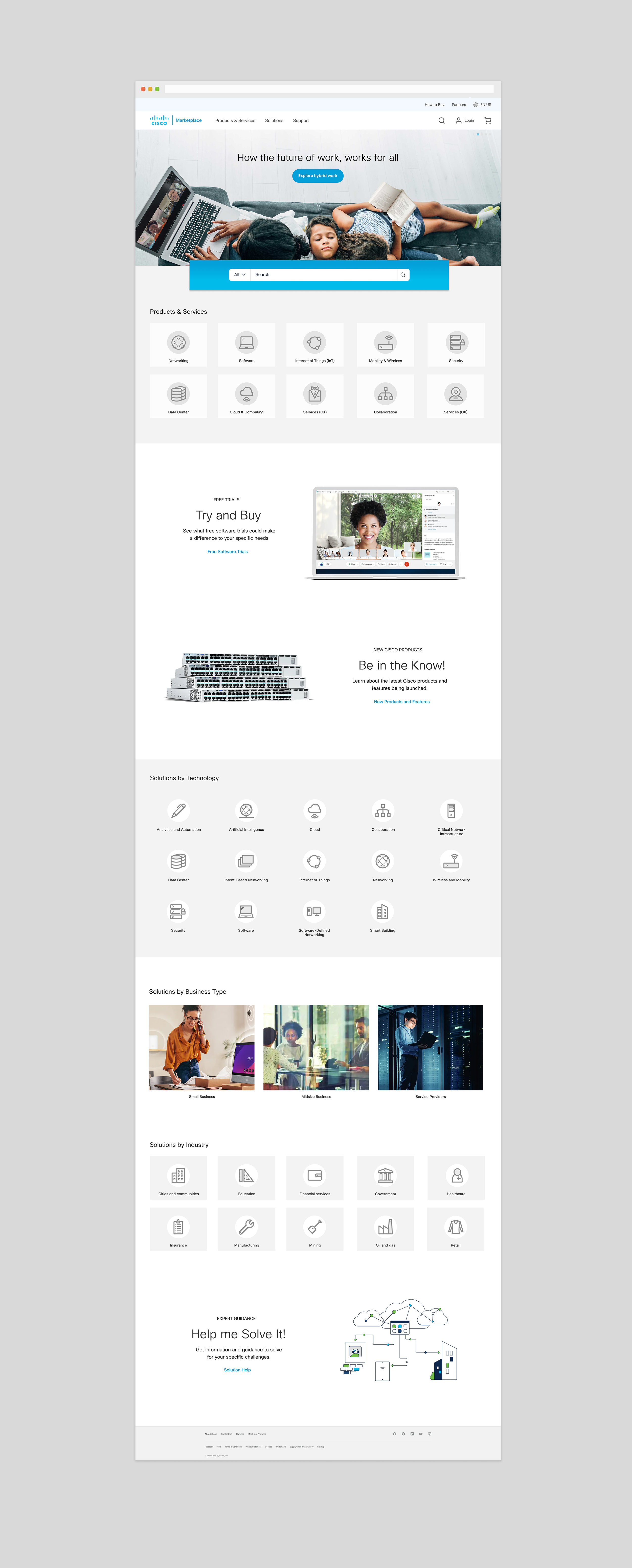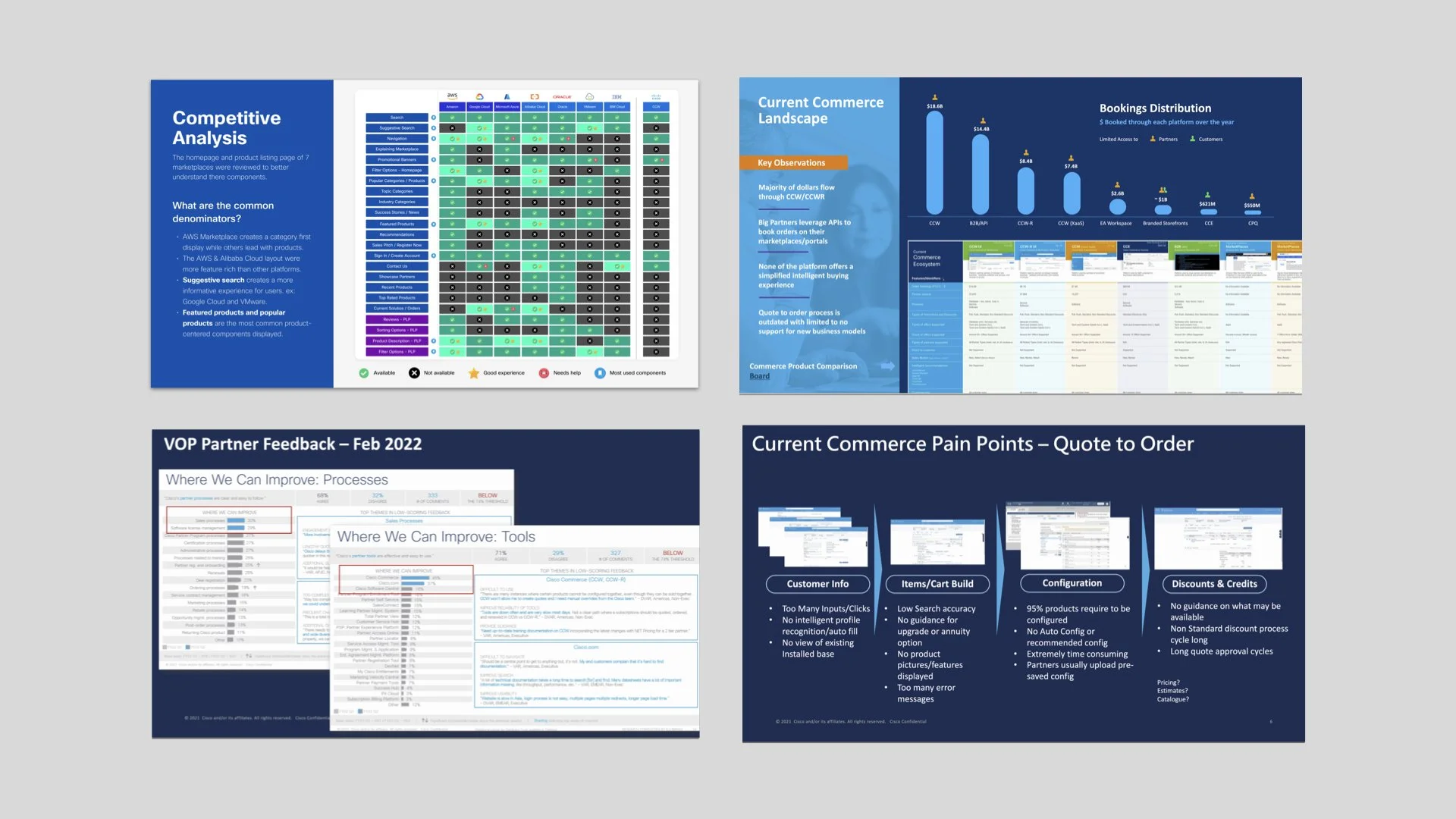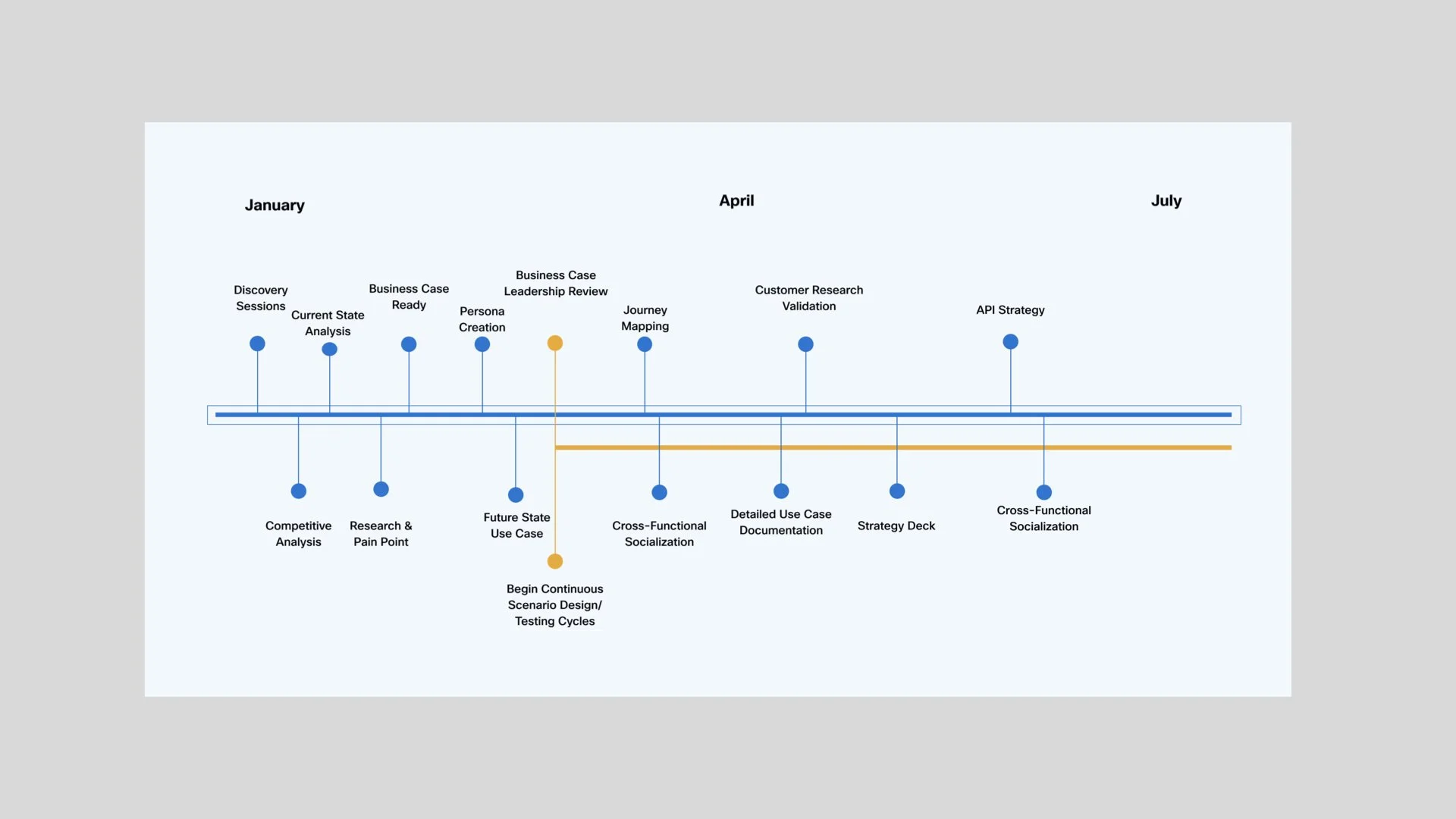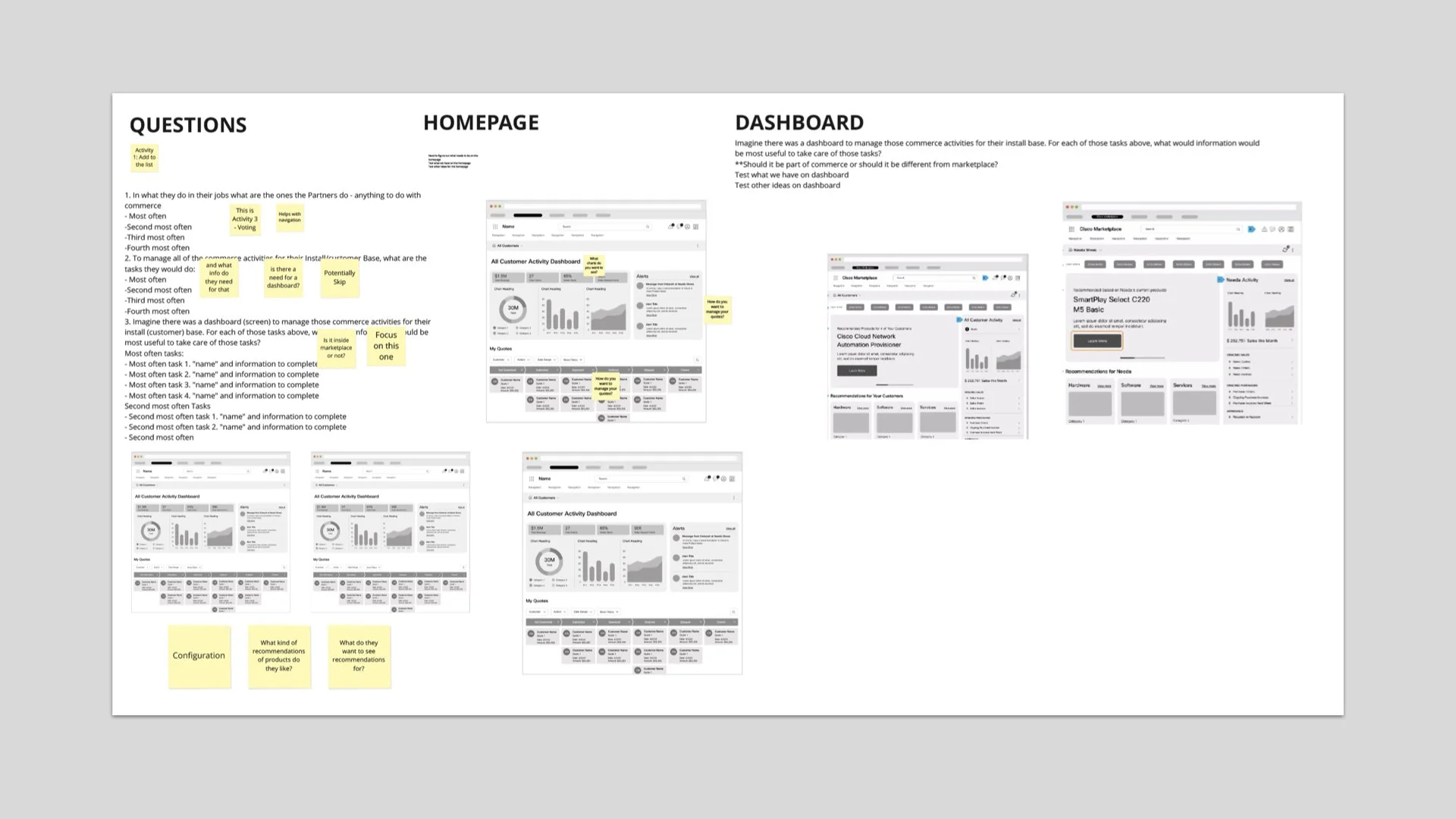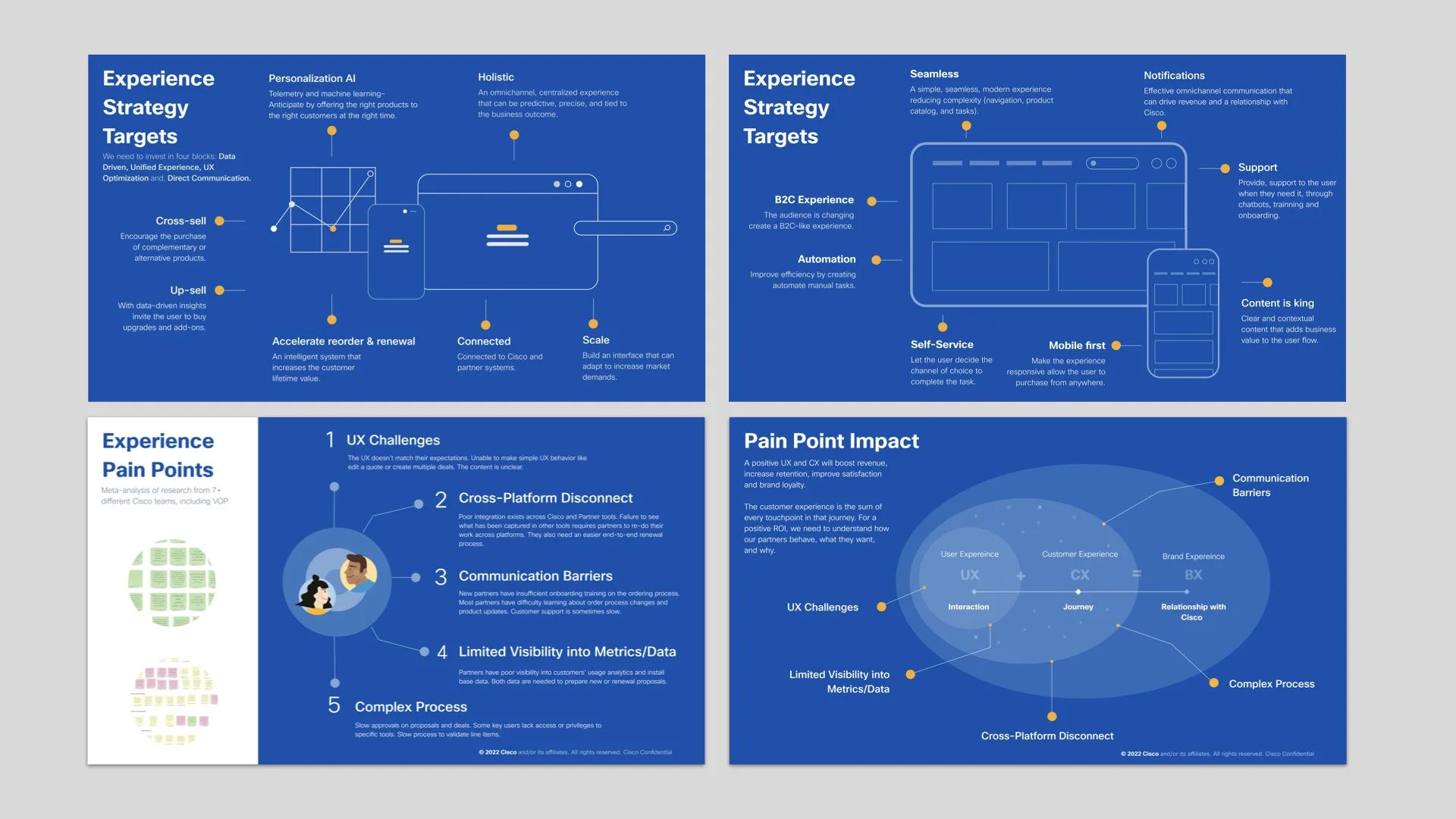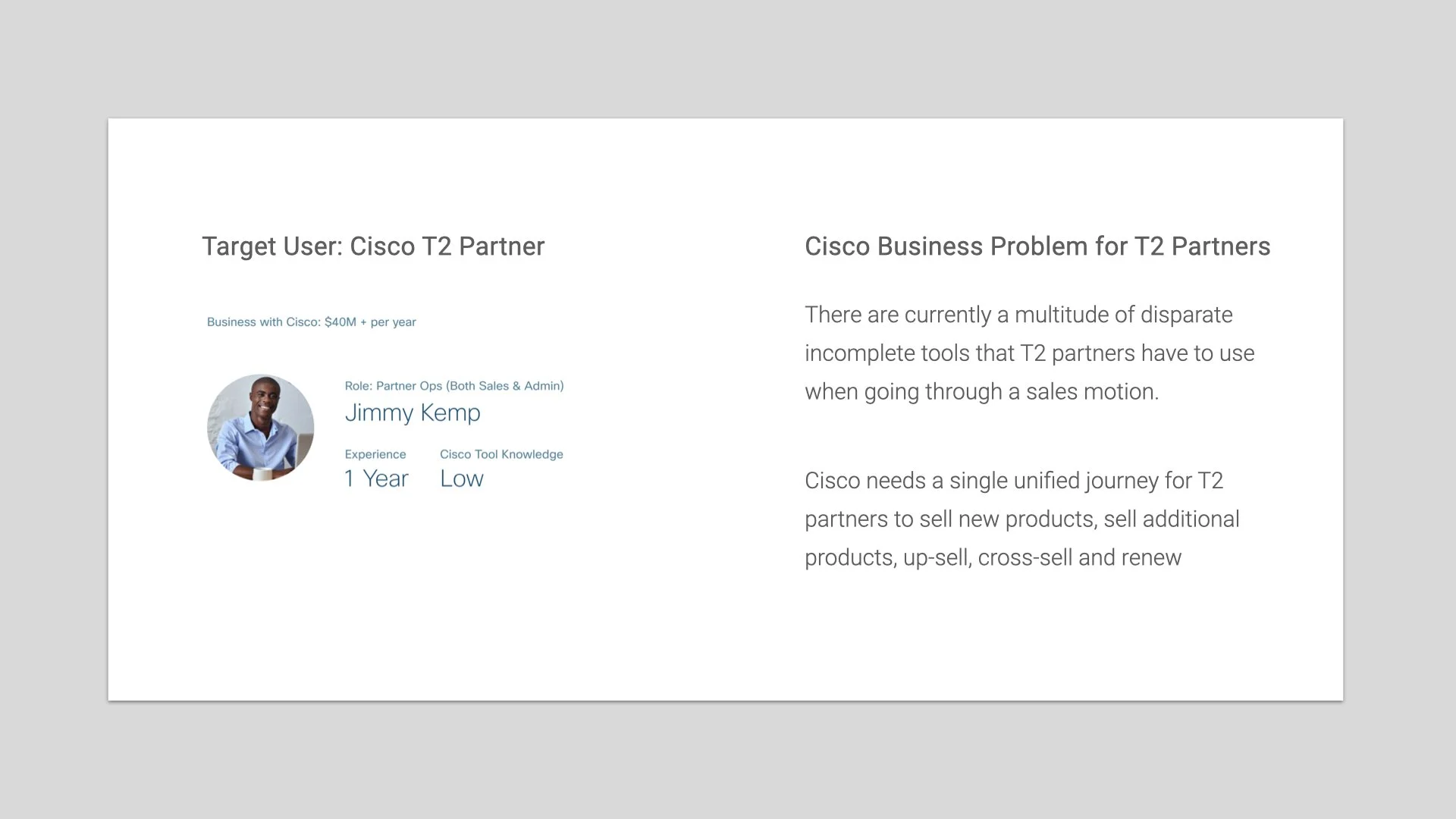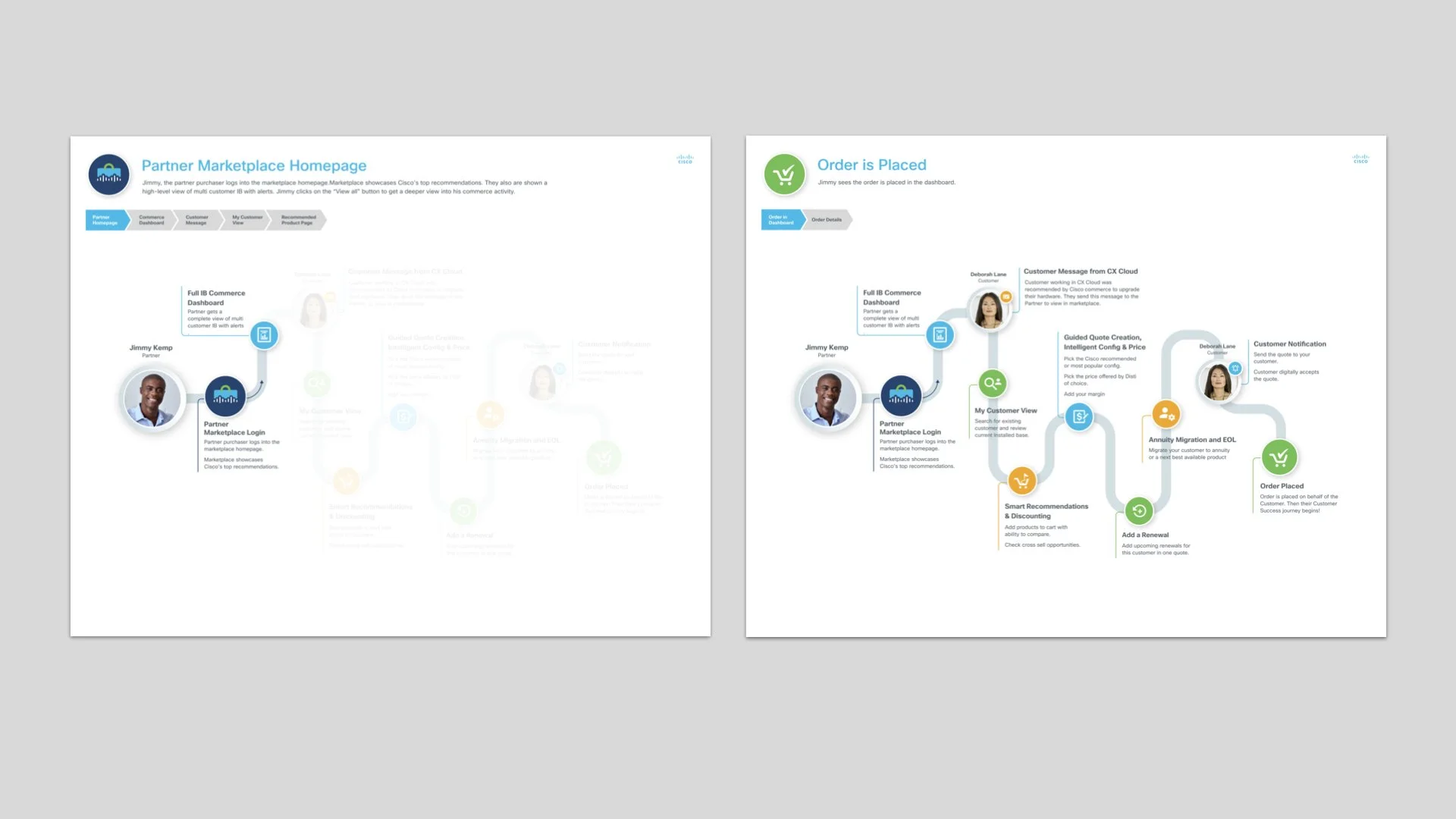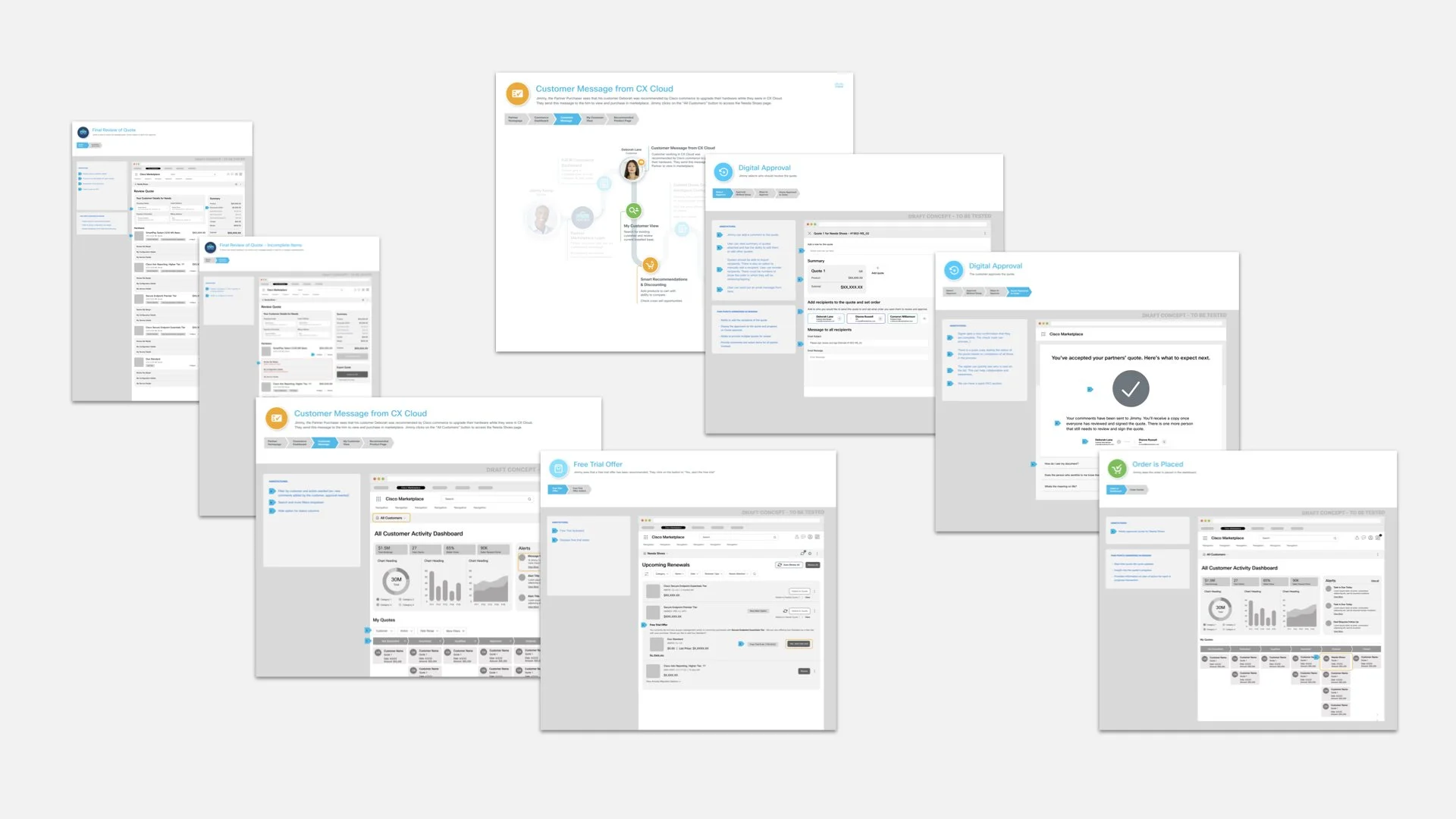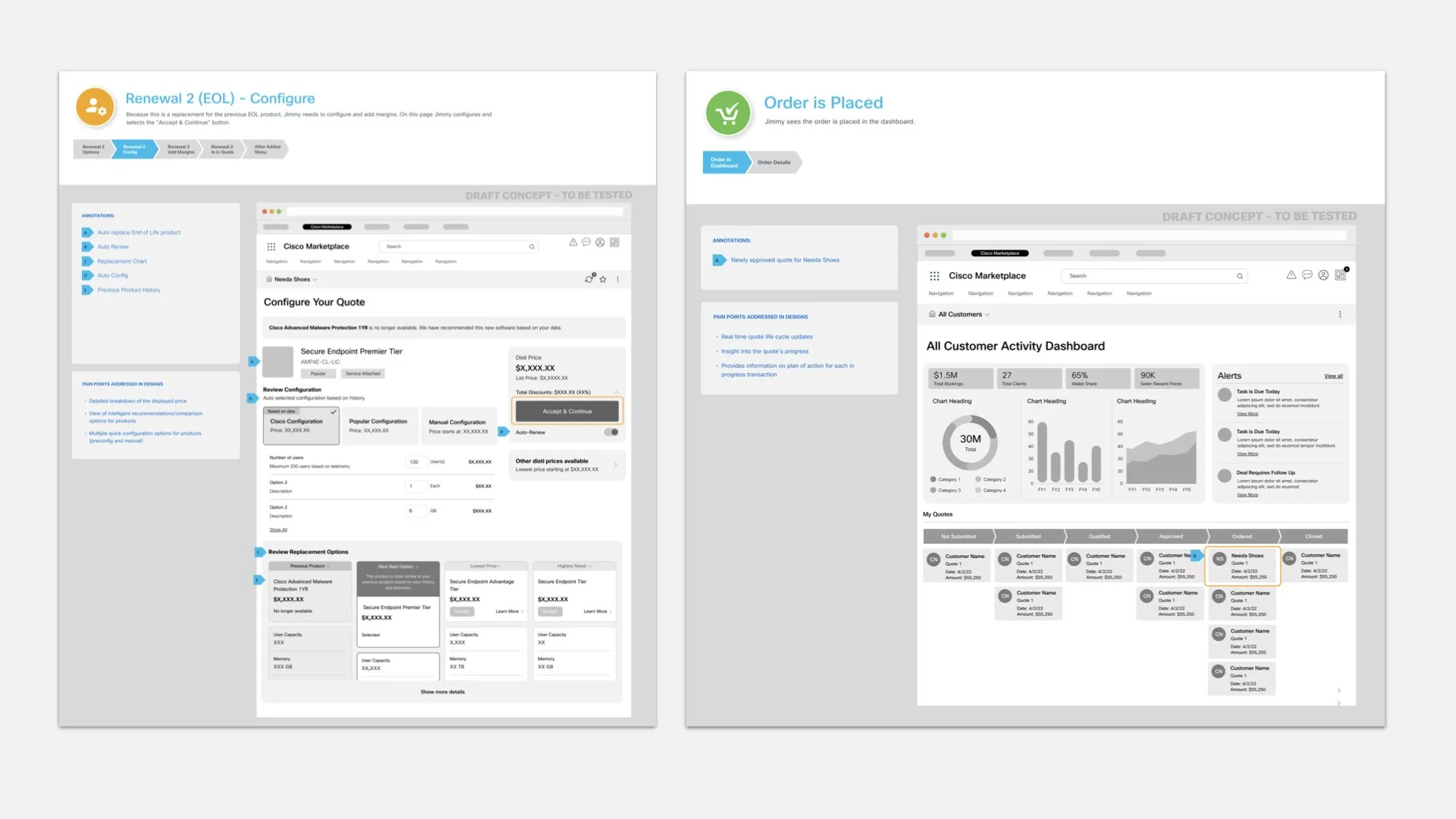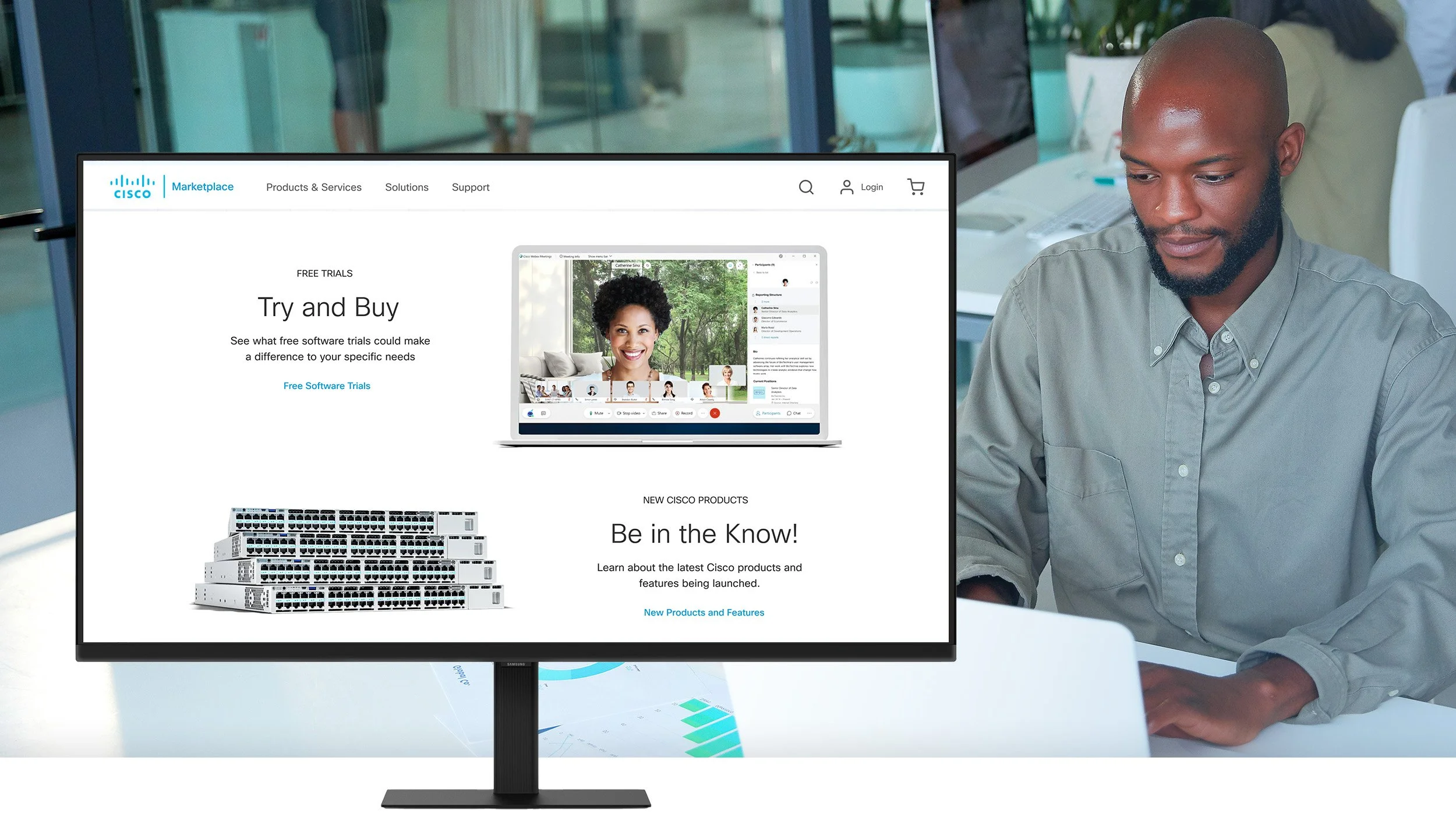
FEATURED CASE STUDY: CISCO SAAS
-

The Challenge
Cisco’s $50B commerce ecosystem spanned quoting, purchasing, and renewal flows used by partners, sellers, and fulfillment teams worldwide. These tools were fragmented across multiple platforms, lacked consistent workflows, and made it difficult for partners to efficiently serve their customers.
When I joined the initiative, there were no business teams assigned, no defined users, and no agreed-upon goals. The experience was high-volume, high-stakes, and critical to Cisco’s profitability — but there was no validated direction.
The opportunity was to reimagine these workflows into a cohesive, profitable, and user-centered system that could scale globally.
-

Actions: 1. Building Alignment & Clarifying Needs
I began by organizing cross-functional workshops to identify stakeholders, align business groups, and uncover internal perspectives. These sessions helped surface assumed pain points, unvalidated goals, and conflicting priorities across product and operations.
By building relationships early, I established the trust needed to move quickly in an undefined problem space. -
New List Item
Description goes here
RETHINKING $50B COMMERCE AT SCALE
Transforming SaaS for B2B & Consumer Ecosystems
To support Cisco’s $50B commerce ecosystem, I led the rethinking and redesign of core ordering and partner tools used to manage quoting, purchasing, and renewal flows. This work required deep experience architecture planning and the ability to unify fragmented, high-volume workflows across internal and partner-facing systems. I collaborated closely with research and multiple product and operations teams to improve the end-to-end conversion and acquisition model for global users.
Role: UX Strategy & Design Lead — Directed strategy, hands-on design, stakeholder alignment, team mentorship, and cross-functional collaboration with research, engineering, and executives.
The Challenge
Cisco’s $50B commerce ecosystem spanned quoting, purchasing, and renewal flows used by partners, sellers, and fulfillment teams worldwide. These tools were fragmented across multiple platforms, lacked consistent workflows, and made it difficult for partners to efficiently serve their customers.
When I joined the initiative, there were no business teams assigned, no defined users, and no agreed-upon goals. The experience was high-volume, high-stakes, and critical to Cisco’s profitability — but there was no validated direction.
The opportunity was to reimagine these workflows into a cohesive, profitable, and user-centered system that could scale globally.
The Work
1. Building Alignment & Clarifying Needs
I began by organizing cross-functional workshops to identify stakeholders, align business groups, and uncover internal perspectives. These sessions helped surface assumed pain points, unvalidated goals, and conflicting priorities across product and operations. By building relationships early, I established the trust needed to move quickly in an undefined problem space.
2. Research & Defining Jobs-To-Be-Done
To fill research gaps and validate assumptions, I ran lightweight internal user tests and concept explorations while co-leading external partner research with Cisco’s 2-tier partners. We conducted interviews and concept testing that both validated existing research and also revealed key disconnects between Cisco’s internal view and how partners actually operated.
This work defined Jobs-To-Be-Done for partner users and allowed us to prioritize the highest-impact user type. With clarity on user needs, I created future-state journeys, clickable wireframes, and prototypes that demonstrated how redesigned workflows could boost efficiency and directly support partner profitability.
3. Designing & Iterating at Scale
Once validated, the scope expanded to additional partner tiers and even consumer-facing use cases. I guided the design team in producing detailed flows, annotated wireframes, and high-fidelity prototypes aligned to roadmap milestones.
I also developed a strategic design framework that could support multiple workstreams. By mapping journeys into detailed sub-steps and annotating improvements, I showed exactly how each design decision enhanced both Cisco’s business value and the partner’s user experience.
4. Storytelling & Securing Executive Buy-In
To unify focus across stakeholders, I created a narrative walkthrough that showed how a Cisco partner could serve their customer using the redesigned tools. I annotated each step with user experience gains and business impact.
This focused storytelling — paired with tangible prototypes — helped overcome complexity and aligned diverse stakeholders. The work was ultimately approved at the VP and SVP level, paving the way for global platform build-out.
Work & Deliverables:
Internal + partner user research (in close partnership with 3 researchers)
Strategy workshops with cross-functional stakeholders
JTBD (jobs to be done) synthesis and user prioritization
Executive-level narrative presentations
Annotated wireframes + working prototypes
Future-state journey mapping
Design strategy aligned to roadmap
Designs from wireframes and flows to hi-fidelity prototypes
Direction for 8 designers working in tandem with me (2 junior, 1 senior, 2 lead).
Impact:
Design strategy and designs approved by VP and SVP leadership
Prototypes and artifacts helped visualize pain points, business impact and usability gains
Provided the roadmap leading from the 0-1 discovery through extended development
Designs credited with aligning user needs to partner profitability
Reflection & Why It Mattered: This initiative successfully transformed a complex commerce ecosystem into a more user-centric and profitable experience. By aligning design with product and engineering around a shared understanding of partner needs, and by leading with a clear strategy and tangible prototypes, I helped lay the groundwork for Cisco's future commerce platform.
RETHINKING $50B COMMERCE AT SCALE
Transforming SaaS for B2B & Consumer Ecosystems
To support Cisco’s $50B commerce ecosystem, I led the rethinking and redesign of core ordering and partner tools used to manage quoting, purchasing, and renewal flows. This work required deep experience architecture planning and the ability to unify fragmented, high-volume workflows across internal and partner-facing systems. I collaborated closely with research and multiple product and operations teams to improve the end-to-end conversion and acquisition model for global users.
Role: UX Strategy & Design Lead — Directed strategy, hands-on design, stakeholder alignment, team mentorship, and cross-functional collaboration with research, engineering, and executives.
The Challenge
Cisco’s $50B commerce ecosystem spanned quoting, purchasing, and renewal flows used by partners, sellers, and fulfillment teams worldwide. These tools were fragmented across multiple platforms, lacked consistent workflows, and made it difficult for partners to efficiently serve their customers.
When I joined the initiative, there were no business teams assigned, no defined users, and no agreed-upon goals. The experience was high-volume, high-stakes, and critical to Cisco’s profitability — but there was no validated direction.
The opportunity was to reimagine these workflows into a cohesive, profitable, and user-centered system that could scale globally.
The Work
1. Building Alignment & Clarifying Needs
I began by organizing cross-functional workshops to identify stakeholders, align business groups, and uncover internal perspectives. These sessions helped surface assumed pain points, unvalidated goals, and conflicting priorities across product and operations. By building relationships early, I established the trust needed to move quickly in an undefined problem space.
2. Research & Defining Jobs-To-Be-Done
To fill research gaps and validate assumptions, I ran lightweight internal user tests and concept explorations while co-leading external partner research with Cisco’s 2-tier partners. We conducted interviews and concept testing that both validated existing research and also revealed key disconnects between Cisco’s internal view and how partners actually operated.
This work defined Jobs-To-Be-Done for partner users and allowed us to prioritize the highest-impact user type. With clarity on user needs, I created future-state journeys, clickable wireframes, and prototypes that demonstrated how redesigned workflows could boost efficiency and directly support partner profitability.
3. Designing & Iterating at Scale
Once validated, the scope expanded to additional partner tiers and even consumer-facing use cases. I guided the design team in producing detailed flows, annotated wireframes, and high-fidelity prototypes aligned to roadmap milestones.
I also developed a strategic design framework that could support multiple workstreams. By mapping journeys into detailed sub-steps and annotating improvements, I showed exactly how each design decision enhanced both Cisco’s business value and the partner’s user experience.
4. Storytelling & Securing Executive Buy-In
To unify focus across stakeholders, I created a narrative walkthrough that showed how a Cisco partner could serve their customer using the redesigned tools. I annotated each step with user experience gains and business impact.
This focused storytelling — paired with tangible prototypes — helped overcome complexity and aligned diverse stakeholders. The work was ultimately approved at the VP and SVP level, paving the way for global platform build-out.
Work & Deliverables:
Internal + partner user research (in close partnership with 3 researchers)
Strategy workshops with cross-functional stakeholders
JTBD (jobs to be done) synthesis and user prioritization
Executive-level narrative presentations
Annotated wireframes + working prototypes
Future-state journey mapping
Design strategy aligned to roadmap
Designs from wireframes and flows to hi-fidelity prototypes
Direction for 8 designers working in tandem with me (2 junior, 1 senior, 2 lead).
Impact:
Design strategy and designs approved by VP and SVP leadership
Prototypes and artifacts helped visualize pain points, business impact and usability gains
Provided the roadmap leading from the 0-1 discovery through extended development
Designs credited with aligning user needs to partner profitability
Reflection & Why It Mattered: This initiative successfully transformed a complex commerce ecosystem into a more user-centric and profitable experience. By aligning design with product and engineering around a shared understanding of partner needs, and by leading with a clear strategy and tangible prototypes, I helped lay the groundwork for Cisco's future commerce platform.
I started by establishing relationships with business partners and stakeholders to identify business needs and goals and the opportunities for the work.
I created a roadmap and planned user research to understand how customers currently interact with Cisco and what could make those interactions more effective and profitable. This discovery work tested key business assumptions and revealed insights that led to design solutions focused on increasing value and profitability for Cisco’s customers.
To inform the research, I called out key pieces of information that were important to learn from the testing and user interviews. I provided direction for key information needed with my team researcher and also participated and asked questions in the sessions.
Using key insights from the business and Cisco partners, I identified pain points and experience strategy goals to guide the work. I also shared these findings with stakeholders to build alignment and maintain momentum.
Cisco has many types of commerce users with distinct goals and pain points. To get started, I partnered with the Cisco business team to identify the most strategic user type to focus on—based on multiple factors—to guide initial research, design strategy, and early designs. This helped us move quickly, maintain momentum, and deliver early wins to build on.
Securing buy-in from Cisco leadership and cross-functional stakeholders was essential. To support this, I defined a simple use case and user journey with a core set of interactions that could scale over time. This approach also made it easier to gather key insights and identify innovation opportunities through iterative review rounds.
The commerce experience was complex—not just in the tasks Cisco partners needed to complete, but also due to the multiple layers of partnerships involved, including partner clients and both internal and external vendors. To ensure both efficiency and scalability, I developed a strategy and design framework that supported multiple workstreams, each addressing different user needs. I also expanded the user journey into detailed sub-steps, clearly outlining the design benefits for both Cisco and its users at each stage of the interaction.
The detailed wireframes were mapped to key milestones in the user journey, with annotations highlighting design improvements and explaining how they enhanced efficiency and profitability for both Cisco partners and the business.
I started by establishing relationships with business partners and stakeholders to identify business needs and goals and the opportunities for the work.
I created a roadmap and planned user research to understand how customers currently interact with Cisco and what could make those interactions more effective and profitable. This discovery work tested key business assumptions and revealed insights that led to design solutions focused on increasing value and profitability for Cisco’s customers.
To inform the research, I called out key pieces of information that were important to learn from the testing and user interviews. I provided direction for key information needed with my team researcher and also participated and asked questions in the sessions.
Using key insights from the business and Cisco partners, I identified pain points and experience strategy goals to guide the work. I also shared these findings with stakeholders to build alignment and maintain momentum.
Cisco has many types of commerce users with distinct goals and pain points. To get started, I partnered with the Cisco business team to identify the most strategic user type to focus on—based on multiple factors—to guide initial research, design strategy, and early designs. This helped us move quickly, maintain momentum, and deliver early wins to build on.
Securing buy-in from Cisco leadership and cross-functional stakeholders was essential. To support this, I defined a simple use case and user journey with a core set of interactions that could scale over time. This approach also made it easier to gather key insights and identify innovation opportunities through iterative review rounds.
The commerce experience was complex—not just in the tasks Cisco partners needed to complete, but also due to the multiple layers of partnerships involved, including partner clients and both internal and external vendors. To ensure both efficiency and scalability, I developed a strategy and design framework that supported multiple workstreams, each addressing different user needs. I also expanded the user journey into detailed sub-steps, clearly outlining the design benefits for both Cisco and its users at each stage of the interaction.
The detailed wireframes were mapped to key milestones in the user journey, with annotations highlighting design improvements and explaining how they enhanced efficiency and profitability for both Cisco partners and the business.
I started by establishing relationships with business partners and stakeholders to identify business needs and goals and the opportunities for the work.
I created a roadmap and planned user research to understand how customers currently interact with Cisco and what could make those interactions more effective and profitable. This discovery work tested key business assumptions and revealed insights that led to design solutions focused on increasing value and profitability for Cisco’s customers.
To inform the research, I called out key pieces of information that were important to learn from the testing and user interviews. I provided direction for key information needed with my team researcher and also participated and asked questions in the sessions.
Using key insights from the business and Cisco partners, I identified pain points and experience strategy goals to guide the work. I also shared these findings with stakeholders to build alignment and maintain momentum.
Cisco has many types of commerce users with distinct goals and pain points. To get started, I partnered with the Cisco business team to identify the most strategic user type to focus on—based on multiple factors—to guide initial research, design strategy, and early designs. This helped us move quickly, maintain momentum, and deliver early wins to build on.
Securing buy-in from Cisco leadership and cross-functional stakeholders was essential. To support this, I defined a simple use case and user journey with a core set of interactions that could scale over time. This approach also made it easier to gather key insights and identify innovation opportunities through iterative review rounds.
The commerce experience was complex—not just in the tasks Cisco partners needed to complete, but also due to the multiple layers of partnerships involved, including partner clients and both internal and external vendors. To ensure both efficiency and scalability, I developed a strategy and design framework that supported multiple workstreams, each addressing different user needs. I also expanded the user journey into detailed sub-steps, clearly outlining the design benefits for both Cisco and its users at each stage of the interaction.
The detailed wireframes were mapped to key milestones in the user journey, with annotations highlighting design improvements and explaining how they enhanced efficiency and profitability for both Cisco partners and the business.
Below is an example of one of the higher fidelity designs and prototypes created for this initiative
